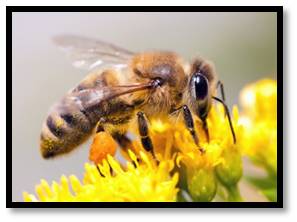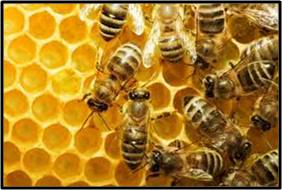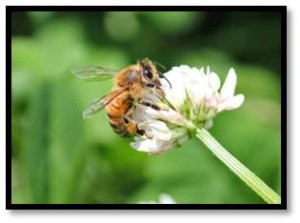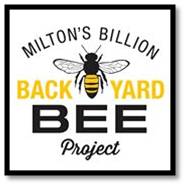Monday Author: Susanne Skinner
Say hello to my little friend. She tips the scales at one tenth of a gram and measures about half an inch. Her formal name is Apis Mellifera but most of us know her by her familiar name – the western honey bee. She is, among other distinctions, the only insect that produces a food eaten by man. In her lifetime she will work tirelessly and her efforts will produce about one–twelfth of a teaspoon of honey,
 But honey, although delicious, is the smallest of the bees’ services. Their greatest contribution is pollination. Without bees most of life would simply die out, humans included. Albert Einstein once said “If the bee disappeared off the face of the earth, man would only have four years left to live.” That’s something to think about.
But honey, although delicious, is the smallest of the bees’ services. Their greatest contribution is pollination. Without bees most of life would simply die out, humans included. Albert Einstein once said “If the bee disappeared off the face of the earth, man would only have four years left to live.” That’s something to think about.
Bee Colonies
The bee makes her home in a colony with some 50,000 other bees and a queen that oversees management of the hive. Her life expectancy is somewhat bounded; dependent on the time of year and the caste of bee. Queens live up to three years, drones die when they mate, and if they haven’t mated by the beginning of winter, they are voted off the island. The only good bee is a productive bee.
In the spring, summer and early fall, a worker bee will live about six weeks. They serve as nursery workers for a few weeks, and then collect nectar and pollen until they die. Workers born in late fall will live longer to keep the Queen warm during the winter.
A World without Bees
Bees occupy a unique place in the grand scheme of things. Our lives and our planet would be a much different place if bees didn’t exist. They are the pollinators of the agricultural world. Worker bees pollinate 80 percent of our flowering crops, or one-third of everything we eat. Another way to look at it is one out of every three bites of food come from a plant that required pollination.
 Pollination is essentially plant reproduction. Without help from animal pollinators, our everyday food supply would be very different. At least one third of the food we’ve come to rely on would no longer be available.
Pollination is essentially plant reproduction. Without help from animal pollinators, our everyday food supply would be very different. At least one third of the food we’ve come to rely on would no longer be available.
Nearly 50 percent of the grocery store’s produce would be missing if there were no bees. No more apples, avocados, broccoli, melon, celery and citrus fruits just to name a few. Wheat, clover and alfalfa, which provide food for cattle and other grazing animals, would also disappear. Say goodbye to milk, cheese, butter, yogurt and ice cream—just a few of my favorite things.
The Importance of Pollinators
A Cornell University study estimated that honeybees pollinate $14 billion worth of seeds and crops every year in the U.S. If they disappeared, most of our insect-pollinated plants would follow, potentially reducing us to a very limited diet. It would be a lonely planet without bees.
Honeybees are disappearing globally at an alarming rate due to pesticides, parasites, malnutrition, disease and loss of their natural habitat. According to research studies a complex variety of factors is at work including Colony Collapse Disorder, a global bee epidemic first identified in 2006.
The cause and the science are not entirely clear, but experts have cited specific pesticides known as neonicotinoids, introduced in the nineties, as a major contributor. The unfortunate combination of all these factors increases the honeybee’s stress and reduces its immune system, which in turn threatens our ecosystem.
Beauty and the Bees
If you plant them they will come. One of the easiest things we can do for our bee friends is to plant a flower garden. By adding to the flower inventory we aid bees in their work. Even if your only garden space is a flower pot or window box on a balcony, planting a few flowers will create a habitat for bees.
 Plant flowers that are unique to the region you live in because local bees have adapted to them. They provide the bees with pollen and nectar and in return, the bees pollinate flowers, increasing the harvest of fruits and vegetables. It’s a win-win.
Plant flowers that are unique to the region you live in because local bees have adapted to them. They provide the bees with pollen and nectar and in return, the bees pollinate flowers, increasing the harvest of fruits and vegetables. It’s a win-win.
When planting flowers think about the following:
- Select single flower tops such as daisies and marigolds, rather than double flower tops like impatiens. Double-headed flowers produce less nectar and make it more difficult for bees to access pollen. The honey bee is designed to maximize the collection of pollen and nectar from flowers.
- Use natural pesticides and fertilizers. Avoid herbicides or pesticides as they can be toxic to bees. Ladybugs, spiders, and praying mantises keep bugs in check naturally.
- Create a bee bath. Bees need a place to get fresh, clean water. Fill a shallow container of water with pebbles or twigs for the bees to land on while drinking. Keep it clean; refresh it daily and the bees will find it.
Learning from the Beekeepers
Friends of mine are bee keepers and I’ve not only learned a lot from them I’ve become a bee enthusiast. My colleague Ray’s 11-year-old son Sebastian started Milton’s Billion Backyard Bee Project to raise awareness of the bees’ plight and nurture a community that supports conservation and backyard beekeeping. We need more people like him to promote the health and well-being of these amazing insects.
 Find a beekeeper in your neighborhood and support him or her with the purchase of local honey—nothing tastes better! This summer we are hoping to offer our back yard as a home for a local hive; doing our part to provide a safe environment for bees to flourish.
Find a beekeeper in your neighborhood and support him or her with the purchase of local honey—nothing tastes better! This summer we are hoping to offer our back yard as a home for a local hive; doing our part to provide a safe environment for bees to flourish.
The health of American agriculture and the health of our honeybees are intertwined and affect our country’s long-term agricultural productivity. If you care about the environment you should care about bees.
Let’s raise awareness and work together to give bees a chance.

Thanks Martha – I am spreading the word! I learned so much when writing this blog and interviewing my bee keeper friends. We would love to do this when we retire but for now are preparing our yard with additional plants to host a hive from a bee-keeping neighbor – which will also bring the butterflies!
Great post about a subject very near and dear to my heart! People should also be very careful where they purchase plants for their gardens and terraces. Last year it came to light that most of the plants at Big Box stores like Home Depot were grown from seeds that had been treated which just means you are planting poisonous food for the bees. Awareness is key. I have asked all my neighboring farmers, large and small, to be aware of my bees. If they must treat their gardens, I requested that they do any spaying first thing in the morning or after dusk when the bees are not out foraging. Everyone was happy to comply, particularly when they witnessed the tremendous increase in produce the very first year I started my bees!!
Good luck with your venture into bee keeping. It is a lovely way to spend an afternoon communing with your ladies!
Wow, I didn’t know this about plants from the big box stores. I get most of my flowers from Russell’s Garden Center so I think those are OK. But no more annuals from Home Depot or Lowe’s for me! I love my bees and they love my lavender, bee balm, day lilies and flowering sedum.